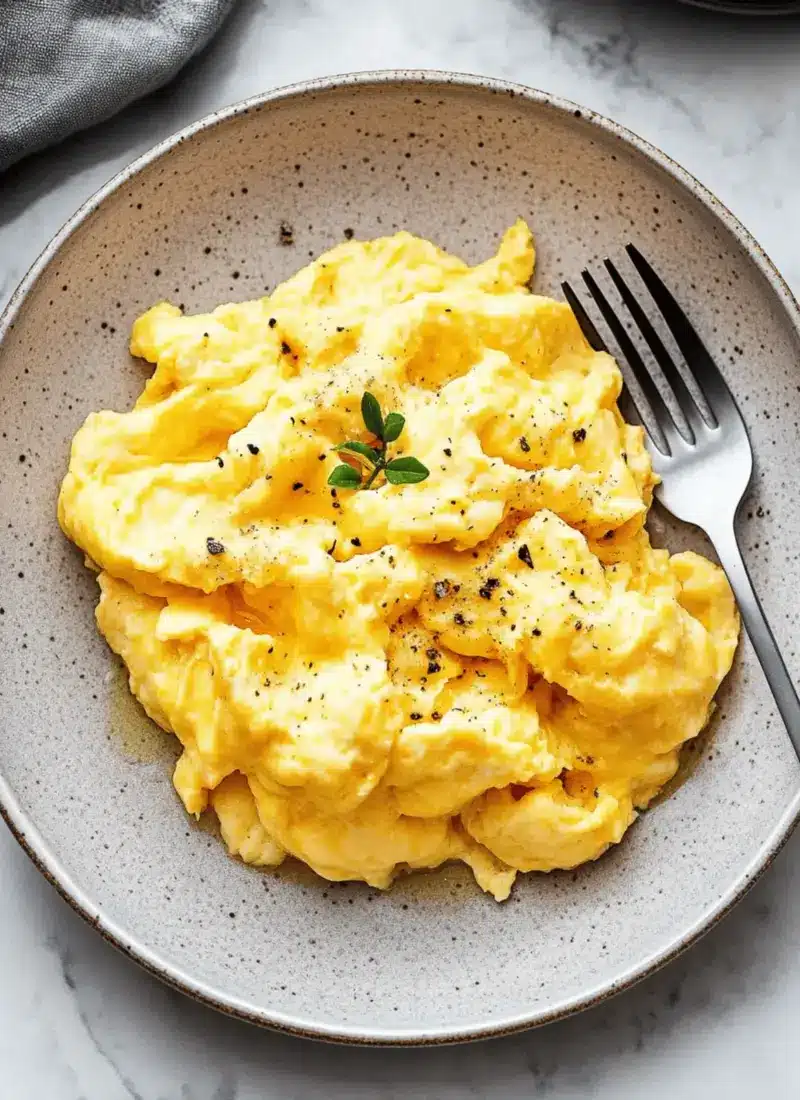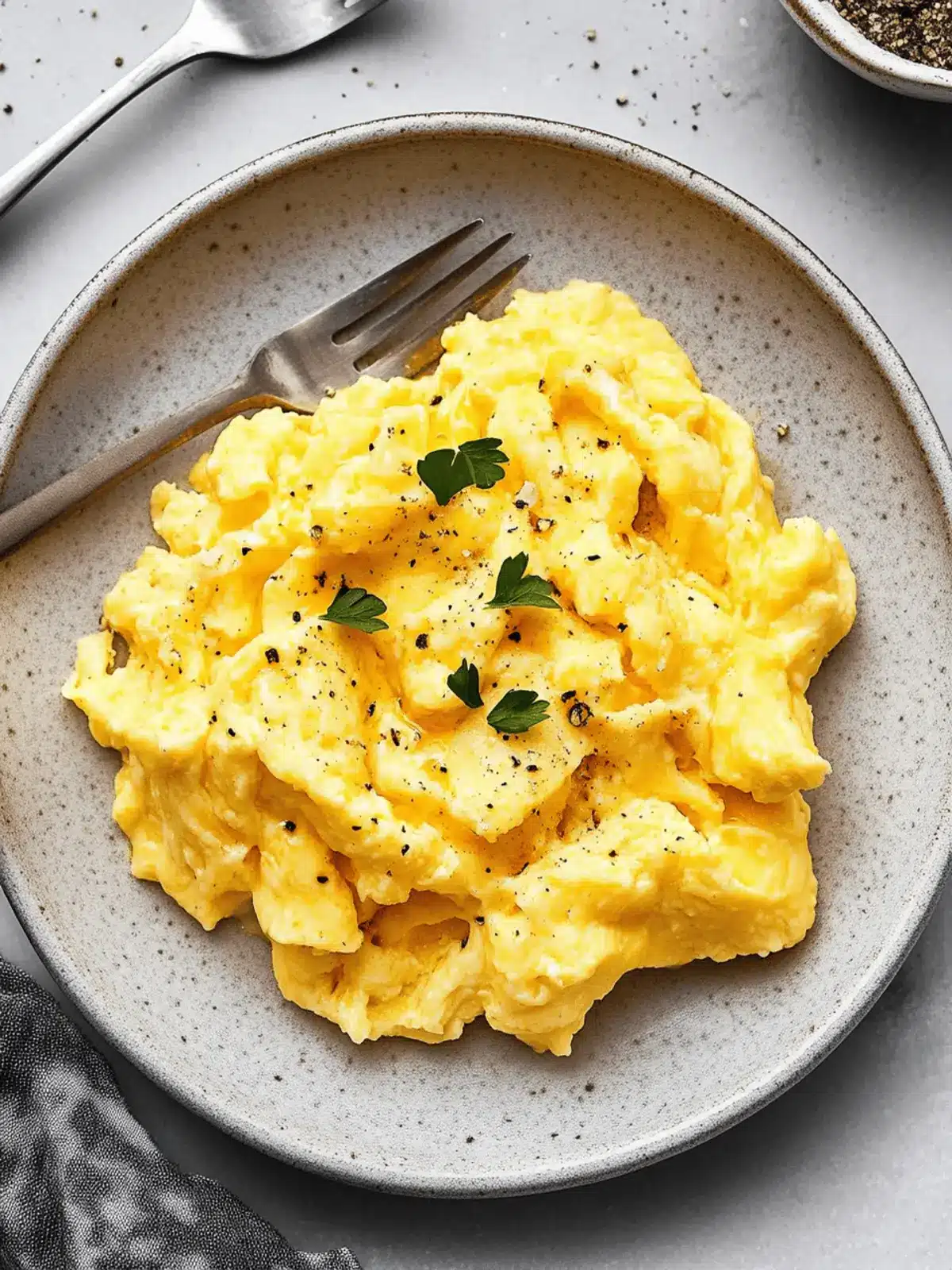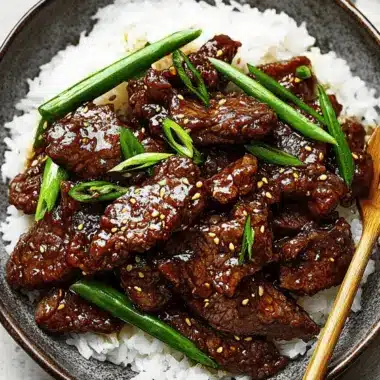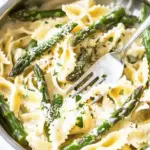There’s nothing quite like the smell of warm, fluffy scrambled eggs filling your kitchen on a bright morning. Remember that feeling of anticipation as you watch those golden yolks transform into creamy clouds on your plate? Cooking scrambled eggs may seem simple, yet mastering the art can elevate your breakfast game to another level. As someone who has often been stuck in a fast-food rut, finding a satisfying, high-protein meal to whip up before starting the day was a game changer for me.
With just a few basic ingredients and a foolproof technique, I’m thrilled to share my method on how to make scrambled eggs that are not only easy to prepare but are also versatile enough to keep your mornings exciting. Whether you prefer them on their own or jazzed up with colorful vegetables and cheese, these scrambled eggs promise to be a delightful start to your day. So, let’s dive into the recipe and bring some comfort back to your breakfast table!
How To Make Scrambled Eggs effortlessly?
Simplicity reigns supreme with just a few ingredients—eggs, salt, and butter—that create a rich, satisfying breakfast. Protein-packed goodness ensures you kickstart your day with energy. Versatile creations await as you can easily add vegetables or cheeses to personalize your scramble. Quick to prepare, these eggs take mere minutes to whip up, making them perfect for busy mornings. Crowd-pleaser potential means even your pickiest eaters will love this fluffy delight, leaving you wonder why fast food was ever an option!
How To Make Scrambled Eggs Ingredients
For the Eggs
- Large Eggs – The star of the dish, providing protein and essential nutrients. Fresh eggs make the fluffiest scrambles!
- Kosher Salt – Essential for enhancing the flavor; adjust to your taste, and feel free to substitute with sea salt if desired.
For Cooking
- Butter – Adds a rich flavor and prevents sticking; for a light alternative, consider using olive oil or bacon grease instead.
With these simple ingredients, you’ll be well on your way to mastering how to make scrambled eggs that are fluffy and satisfying!
How to Make Scrambled Eggs
- Whisk the Eggs: In a mixing bowl, crack the large eggs and sprinkle in the kosher salt. Whisk them together until fully combined and the mixture is slightly frothy, creating that perfect base for fluffiness.
- Prepare the Pan: Choose your pan! For a non-stick skillet, melt some butter over medium heat. For stainless steel, preheat until it’s hot enough for water droplets to dance, then add in the butter to coat the surface.
- Add and Cook the Eggs: Reduce the heat to medium-low and pour the whisked eggs into the pan. Allow them to sit undisturbed for a few seconds so they can start setting nicely.
- Scramble the Eggs: With a silicone or wooden spatula, gently push the eggs across the pan, forming soft curds. Continue this process until the eggs are barely set and still slightly creamy, about 1 to 2 minutes.
- Serve: Turn off the heat and plate your lovely scrambled eggs. Finish with a sprinkle of cracked black pepper for a burst of flavor that complements the dish beautifully.
Optional: Add herbs or cheese for a gourmet touch!
Exact quantities are listed in the recipe card below.
Make Ahead Options
These fluffy scrambled eggs are perfect for meal prep enthusiasts! You can whisk the eggs and season them with salt up to 24 hours in advance, storing the mixture in an airtight container in the refrigerator. This will save you precious time on busy mornings! Just before cooking, give the egg mixture a quick stir to ensure consistency. Additionally, you can chop and prep any desired add-ins, like vegetables or cheese, and refrigerate them separately for up to 3 days. When you’re ready to enjoy your scrambled eggs, simply heat the pan, pour in the prepped egg mixture, and cook until fluffy—resulting in a delightful, high-protein breakfast with minimal effort!
What to Serve with Fluffy Scrambled Eggs?
There’s something truly magical about pairing fluffy scrambled eggs with delightful sides that complement their light, creamy texture.
- Crispy Toast: A classic choice, the crunchy exterior and soft interior of warm toast create a lovely contrast with the eggs. Spread a bit of butter for added richness!
- Fresh Fruit Salad: Bring a burst of sweetness and refreshing flavor to the table with seasonal fruits. The natural sugars will balance the savory notes of the eggs perfectly.
- Sautéed Spinach: This vibrant addition not only adds color but also nutrition, providing a delightful earthiness that complements the fluffy eggs.
- Avocado Slices: Creamy, nutritious avocado matches beautifully with scrambled eggs, adding a rich texture and healthy fats to your meal.
- Breakfast Sausage: A protein-packed pairing! The savory, juicy flavors of sausage will satisfy any breakfast craving and add heartiness to your plate.
- Herbed Cottage Cheese: For a protein boost, steak a scoop of creamy cottage cheese with fresh herbs alongside your eggs. It’s a cooling, refreshing partner to balance the warmth of the scramble.
- Fresh Juice: Kickstart your morning with a glass of freshly squeezed orange juice. The citrus brightness cuts through the richness while providing a burst of freshness!
- Coffee or Tea: A warm beverage of your choice completes the breakfast experience, offering comfort and a cozy start to your day.
These ideas will not only elevate your fluffy scrambled eggs but also turn your breakfast into a comforting feast!
Scrambled Eggs Variations
Feel free to get creative and personalize your scrambled eggs with these delightful twists!
- Veggie-Packed: Stir in sautéed spinach, tomatoes, or bell peppers for a nutritious boost, adding color and flavor to your daily breakfast.
- Cheesy Goodness: Mix in creamy feta, cheddar, or your favorite cheese as the eggs begin to set for a rich, savory experience.
- Herb-Infused: Fresh herbs like chives, parsley, or dill sprinkled on top will elevate the dish with vibrant flavors and a beautiful presentation.
- Creamy Avocado: Add slices of ripe avocado on top upon serving for a satisfying and creamy contrast that enhances each bite.
- Spicy Kick: A few dashes of hot sauce or a sprinkle of red pepper flakes can turn your eggs into a zesty morning treat that will wake up your taste buds!
- Dairy-Free: Substitute regular milk with almond or oat milk for a vegan-friendly version without losing that delightful creaminess.
- Smoked Salmon: For a touch of elegance, top your scrambled eggs with thin slices of smoked salmon, creating a sophisticated brunch option that’s full of flavor.
- Breakfast Burrito: Wrap your scrambled eggs in a warm tortilla with beans, cheese, and salsa for a hearty, on-the-go breakfast that fills you up and satisfies!
Storage Tips for Scrambled Eggs
- Fridge: Store leftover scrambled eggs in an airtight container for up to 3 to 4 days. This keeps them fresh while preventing any odors from mingling with other foods.
- Reheating: When ready to enjoy again, gently reheat in a non-stick skillet over low heat, stirring occasionally. This helps maintain their fluffy texture without drying them out.
- Freezer: For longer storage, you can freeze scrambled eggs in a freezer-safe container for up to 1 month. Thaw overnight in the fridge before reheating.
- Avoiding Waste: If you have extra, consider making breakfast burritos or omelets later in the week with your stored scrambled eggs for a quick and delicious meal!
Expert Tips for Scrambled Eggs
- Egg Temperature: Use eggs at room temperature for fluffier scrambled eggs; cold eggs from the fridge can lead to denser results.
- Gentle Heat: Cook your scrambled eggs over medium-low heat. High heat can make them tough and rubbery, ruining that fluffy texture.
- Timing is Key: Avoid overcooking. Remove the eggs from heat when they are still slightly underdone—they will continue to cook off the heat, achieving the perfect creaminess.
- Add Dairy for Fluffiness: A splash of milk or cream before whisking can enhance the fluffiness of your scrambled eggs; just a tablespoon will do!
- Experiment with Add-ins: Feel free to customize with vegetables or cheese. Just remember to add them after the eggs have set slightly to maintain the right consistency.
Happy cooking as you master how to make scrambled eggs that elevate your breakfast experience!
How to Make Scrambled Eggs Recipe FAQs
What types of eggs should I use for scrambled eggs?
Absolutely, for the best results, I recommend using large, fresh eggs. Fresh eggs not only offer superior flavor but also help create a fluffier texture in your scramble. If you have access to free-range or organic eggs, those are excellent options too, as they tend to have richer yolks.
How do I store leftover scrambled eggs properly?
Leftover scrambled eggs can be stored in an airtight container in the fridge for up to 3 to 4 days. Be sure to allow them to cool to room temperature before sealing the container to avoid condensation, which can lead to spoilage. When you’re ready to enjoy them again, reheat gently in a non-stick skillet over low heat, stirring occasionally to keep them fluffy.
Can I freeze scrambled eggs?
Yes, you can! To freeze scrambled eggs, allow them to cool completely, then transfer them to a freezer-safe container or a resealable freezer bag. Be sure to remove as much air as possible from the bag before sealing it. You can freeze scrambled eggs for up to 1 month! When you’re ready to enjoy, thaw them overnight in the fridge and reheat gently.
What should I do if my scrambled eggs turn out rubbery?
It’s a common issue, but don’t worry! Overcooking is usually the culprit for rubbery eggs. To avoid this, always cook on medium-low heat, and remember to remove the eggs from the pan when they’re still slightly undercooked, as they’ll continue to cook off the heat. Adding a splash of milk or water to the eggs before whisking can also help keep them tender.
Are there any dietary considerations for scrambled eggs?
Of course! Scrambled eggs are naturally high in protein and gluten-free, making them suitable for most diets. However, if you’re concerned about cholesterol, consider using more egg whites than yolks. For those with food allergies, ensure to check if anyone has a dairy allergy if you’re opting to cook with butter or cheese, as these can be easily substituted with dairy-free options like olive oil or vegan cheese.
Can I add vegetables to my scrambled eggs?
Very much so! Adding vegetables is a great way to boost the nutrition of your scrambled eggs. I often recommend sautéing your favorite veggies, like spinach, bell peppers, or mushrooms, in the skillet before adding the eggs. Just wait until the eggs have set slightly before folding in the vegetables to ensure a perfect consistency without making the eggs watery.
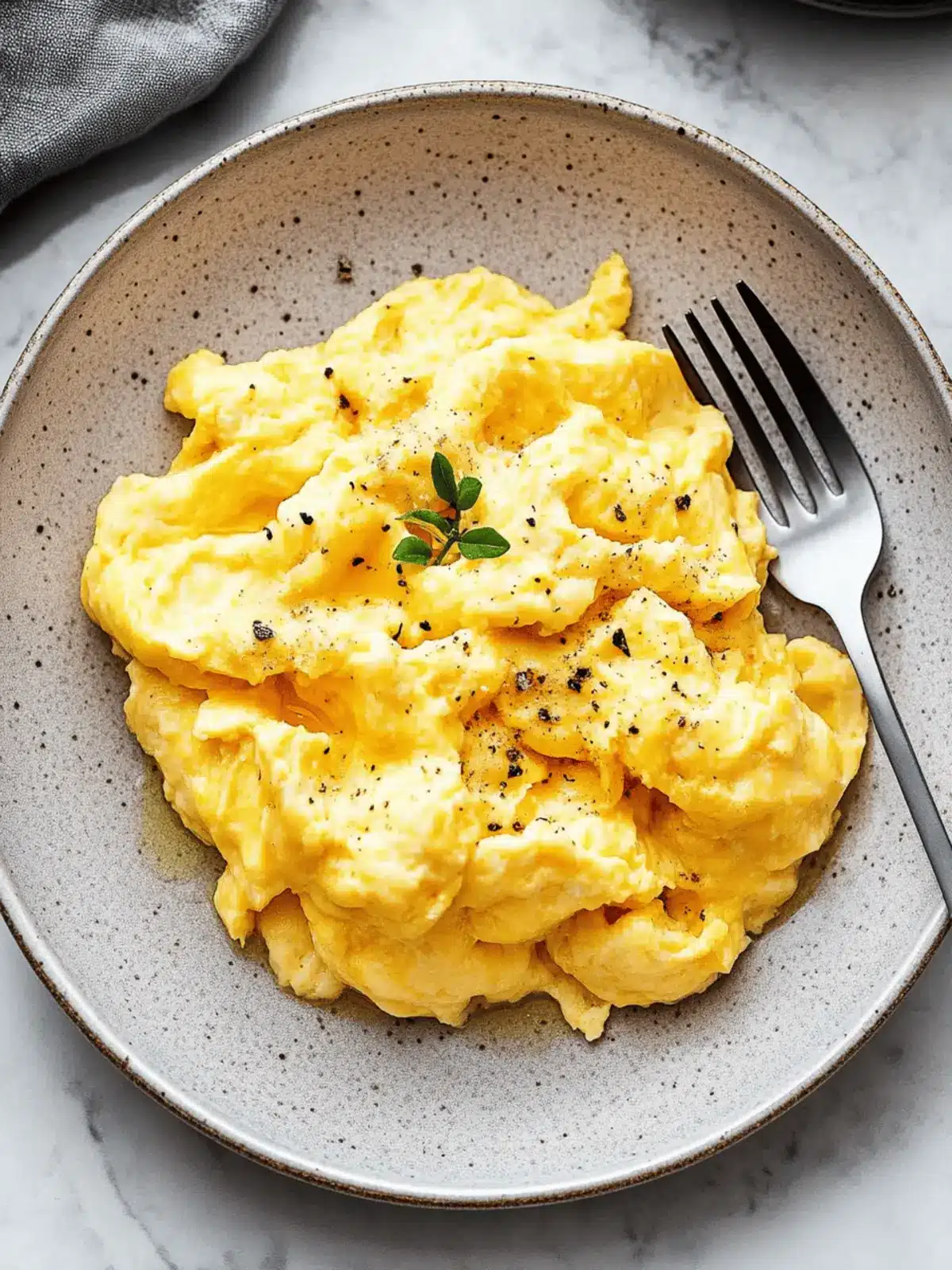
How to Make Scrambled Eggs: Fluffy, Protein-Packed Delight
Ingredients
Equipment
Method
- Whisk the eggs and kosher salt together in a mixing bowl until fully combined and slightly frothy.
- Melt butter in a non-stick skillet over medium heat.
- Reduce heat to medium-low and pour the whisked eggs into the skillet, allowing them to sit undisturbed.
- Gently push the eggs across the pan with a spatula, scrambling them until barely set and slightly creamy, about 1 to 2 minutes.
- Turn off the heat, plate the eggs, and sprinkle with cracked black pepper before serving.

